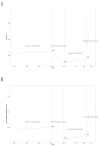Global trends in depressive disorder prevalence and DALYs among young populations: a comprehensive analysis from 1990 to 2021
- PMID: 39716116
- PMCID: PMC11667871
- DOI: 10.1186/s12888-024-06419-2
Global trends in depressive disorder prevalence and DALYs among young populations: a comprehensive analysis from 1990 to 2021
Abstract
To analyze the trend changes in the disease burden of depressive disorder (DD) among youth and adolescents aged 10 to 29 years globally from 1990 to 2021 to provide a theoretical basis for the prevention and treatment of DD in young populations. Utilizing data from the Global Burden of Disease Study 2021, prevalence rates and disability-adjusted life years (DALYs) were employed as indicators. Trends in the disease burden of DD among global youth aged 10 to 29 years from 1990 to 2021 were analyzed with joinpoint regression models. The analysis incorporated major risk factors. Concurrently, an age-period-cohort model was used to provide a more comprehensive assessment of the prevalence and burden of DD. Over the past 30 years, the prevalence rates of DD and DALYs rate among the 10-29-year-old age group generally showed an increasing trend, with values for females being consistently higher than values for males. Notably, compared with the other age groups, the 10- to 14- year-old age group presented more significant increases in both prevalence and DALYs. Regional disparity analysis revealed that while high-sociodemographic index (SDI) regions showed an increasing trend in DD prevalence and DALYs, middle- to low-SDI regions showed some decline. This study highlights the global disease burden of depressive disorder among young populations. The significant increase in both prevalence and DALYs in the 10- to 14-year-old age group emphasizes the trend toward an earlier onset of depressive disorder, also underlining the disparities in depressive disorder management between high-SDI and low-SDI regions. Clinical trial number: not applicable.
Keywords: Age-period-cohort analysis; Depressive disorder; Disease burden; Youth and adolescents.
© 2024. The Author(s).
Conflict of interest statement
Declarations. Ethics approval and consent to participate: This study was based on publicly available data from the Global Burden of Disease (GBD) study provided by the Institute for Health Metrics and Evaluation ( https://vizhub.healthdata.org/gbd-results/ ). As the study utilized secondary data without directly involving human participants, no specific institutional ethics approval was required. Additionally, the study complies with the principles of the Declaration of Helsinki ( http://www.wma.net/en/30publications/10policies/b3/index.html ). Competing interests: The authors declare no competing interests.
Figures




Similar articles
-
Trends in Prevalent Cases and Disability-Adjusted Life-Years of Depressive Disorders Worldwide: Findings From the Global Burden of Disease Study From 1990 to 2021.Depress Anxiety. 2025 Apr 24;2025:5553491. doi: 10.1155/da/5553491. eCollection 2025. Depress Anxiety. 2025. PMID: 40313474 Free PMC article.
-
Global trends of depressive disorders among women of reproductive age from 1990 to 2021: a systematic analysis of burden, sociodemographic disparities, and health workforce correlations.BMC Psychiatry. 2025 Mar 20;25(1):263. doi: 10.1186/s12888-025-06697-4. BMC Psychiatry. 2025. PMID: 40114132 Free PMC article.
-
The long-term spatio-temporal trends in burden and attributable risk factors of major depressive disorder at global, regional and national levels during 1990-2019: a systematic analysis for GBD 2019.Epidemiol Psychiatr Sci. 2024 May 20;33:e28. doi: 10.1017/S2045796024000295. Epidemiol Psychiatr Sci. 2024. PMID: 38764153 Free PMC article.
-
Global burden of stroke in adolescents and young adults (aged 15-39 years) from 1990 to 2019: a comprehensive trend analysis based on the global burden of disease study 2019.BMC Public Health. 2024 Jul 30;24(1):2042. doi: 10.1186/s12889-024-19551-1. BMC Public Health. 2024. PMID: 39080669 Free PMC article.
-
Global, regional, and national temporal trends in prevalence for depressive disorders in older adults, 1990-2019: An age-period-cohort analysis based on the global burden of disease study 2019.Ageing Res Rev. 2024 Sep;100:102443. doi: 10.1016/j.arr.2024.102443. Epub 2024 Aug 7. Ageing Res Rev. 2024. PMID: 39097004 Review.
Cited by
-
Sugar-sweetened beverage consumption and depressive symptoms among college students in northeastern China: The mediating role of mobile phone use addiction.Prev Med Rep. 2025 Jun 2;55:103123. doi: 10.1016/j.pmedr.2025.103123. eCollection 2025 Jul. Prev Med Rep. 2025. PMID: 40529599 Free PMC article.
-
Network Analysis of Premonitory Urges, Tic Symptoms, Obsessive-Compulsive Symptoms, and Quality of Life in Drug-Naïve Children and Adolescents with Tic Disorder.Child Psychiatry Hum Dev. 2025 Apr 16. doi: 10.1007/s10578-025-01838-y. Online ahead of print. Child Psychiatry Hum Dev. 2025. PMID: 40238019
-
Incidence and prevalence of dysthymia among young adults in China, 1990-2021, with forecasts to 2046: an age-period-cohort analysis of the Global Burden of Disease Study 2021.BMC Psychiatry. 2025 Mar 13;25(1):238. doi: 10.1186/s12888-025-06680-z. BMC Psychiatry. 2025. PMID: 40082857 Free PMC article.
-
Heightened subcortical reactivity to uncertain-threat is associated with future internalizing symptoms, conditional on stress exposure.bioRxiv [Preprint]. 2025 Jun 12:2025.06.11.659182. doi: 10.1101/2025.06.11.659182. bioRxiv. 2025. PMID: 40661638 Free PMC article. Preprint.
References
-
- W.H.O. (WHO), Health AM. 2021. https://www.who.int/zh/news-room/fact-sheets/detail/adolescent-mental-he.... (Accessed October 2, 2024.
-
- Siyoum M, Kibrom E, Fanta T, Matheyose E, Adem K, Bekele D, Asfaw H, Darcho SD, Dereje J. Prevalence of treatment-resistant depression and associated factors among major depressive disorder follow-up patients at Saint Amanuel Mental Specialised Hospital in Ethiopia: a cross-sectional study. BMJ Open. 2024;14(11):e087006. - PMC - PubMed
-
- Herrman H, Patel V, Kieling C, Berk M, Buchweitz C, Cuijpers P, Furukawa TA, Kessler RC, Kohrt BA, Maj M, McGorry P, Reynolds CF 3rd, Weissman MM, Chibanda D, Dowrick C, Howard LM, Hoven CW, Knapp M, Mayberg HS, Penninx B, Xiao S, Trivedi M, Uher R, Vijayakumar L, Wolpert M. Time for united action on depression: a Lancet-World Psychiatric Association Commission. Lancet. 2022;399(10328):957–1022. - PubMed
-
- Menard C, Pfau ML, Hodes GE, Kana V, Wang VX, Bouchard S, Takahashi A, Flanigan ME, Aleyasin H, LeClair KB, Janssen WG, Labonté B, Parise EM, Lorsch ZS, Golden SA, Heshmati M, Tamminga C, Turecki G, Campbell M, Fayad ZA, Tang CY, Merad M, Russo SJ. Social stress induces neurovascular pathology promoting depression. Nat Neurosci. 2017;20(12):1752–60. - PMC - PubMed
MeSH terms
LinkOut - more resources
Full Text Sources
Medical
Miscellaneous

